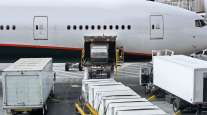Changes in LTLs’ Vocabulary Illustrate Improving Business
This story appears in the Nov. 15 print edition of Transport Topics.
Unfamiliar words such as “stability” and “price increases” are creeping into the less-than-truckload sector’s vocabulary these days, after a turbulent two years of rate cutting, market-share swings and some astronomical losses.
Publicly traded LTL carriers as a group crept back to profitability in the third quarter, with total operating income, excluding interest and taxes, of $42.3 million. That amount includes YRC’s $13 million operating loss.
By comparison, publicly traded LTL carriers as a group lost more than $200 million on their operations last year, excluding YRC Worldwide Inc., which lost $892.3 million all by itself.
Con-way Inc.’s LTL unit reported $13.1 million operating income, and CEO Doug Stotlar said on a Nov. 3 conference call that LTL tonnage had “stabilized in a desirable range” in September.
“Productivity has stabilized, and we are continuing to focus on a mix of business that provides long-term profitable growth,” he said.
He also used the words “relatively stable” to describe the pricing environment.
Despite that late-quarter improvement, Con-way’s revenue per 100 pounds of freight shipped was 17% below pre-recession levels and pounds shipped per day was up 14%, reflecting the move to boost market share by lowering rates last year when capacity was plentiful.
The turning point in pricing occurred during the third quarter, said Earl Congdon, Old Dominion Freight Line’s executive chairman, during a conference call.
“During the third quarter it is our view that industry pricing reached an inflection point and competitive pricing pressure eased,” said David Congdon, Old Dominion’s CEO. This created what he called “the most positive pricing environment we have seen since mid-2007.”
That improvement allowed Old Dominion to more than double its operating income to $43.3 million and post an operating ratio of 89.0 that led publicly traded carriers.
“As market conditions have improved, the commentary on LTL pricing is more positive,” said Judy McReynolds, CEO of Arkansas Best Corp., parent of ABF Freight System, whose operating loss was cut to $2.6 million.
Other CEOs also reported improved pricing. That included Rick Gaetz at Vitran, where LTL operating income was $3 million; Rick O’Dell at Saia, whose operating income was $6.5 million, and Mark DiBlasi of Roadrunner Transportation Systems, which posted $7.9 million in operating income.
“Pricing in the industry remains competitive, but we are seeing it tighten,” YRC CEO William Zollars said on a Nov. 5 investor call. He noted that contracts were being renewed at 3.5% higher rates, helped by its general rate increase more than two months earlier than usual. Other carriers followed by also increasing rates.
“It’s nice to see some of the other competitors that haven’t been [keeping rates firm] in the past starting to get religion,” Zollars said. “We think that can only help the industry dynamics.”
YRC on Nov. 5 reported a net loss of $61.7 million, an improvement from the $158.7 million in last year’s third quarter. Revenue dipped 5% to $1.14 billion.
“We have stabilized the patients and we are working on getting them better,” Dahlman Rose analyst Jason Seidl told TT. “After a couple of years of difficult pricing caused by significant excess capacity, volume increases are absorbing capacity in the LTL industry, and pricing actions appear disciplined.”
Satish Jindel, who heads SJ Consulting, said that even the recent improvements leave the industry well below levels of adequate profitability.
His firm computed a third-quarter weighted average operating ratio of 99.1 for publicly traded fleets. That was better than the 102 in last year’s third quarter, but significantly worse than the pre-recession benchmark of 95.2.
Many public LTL carriers also lag when stacked up against other truckers, he said, noting that the largest privately held competitors averaged about a 95 operating ratio for the third quarter.
Publicly traded truckload carriers did even better, averaging a 93 operating ratio in the third quarter, while package carriers came in at 89.
Jindel said LTL companies need to make basic changes. “With excess capacity going away, why are LTL carriers not able to get better margins?” he asked.
Jindel’s answer was that carriers haven’t changed their operating model for decades, with a pricing system that can give shippers 200 free pounds in a 980-pound shipment, weighing methods that don’t work well and equipment that is too large for what he said are smaller, lighter shipments today.
Seidl stressed the need for publicly traded LTL carriers with weak profits to boost future margins by building on modest improvements. Otherwise, he said, they face operating capacity pitfalls next year as old equipment breaks down.
“Some companies have killed capital spending for two years,” Seidl said, “and they won’t be buyers until margins improve. You can’t justify equipment purchases with a 2% profit margin.
“If LTLs can get contract rate increases that boost margins to the 5%-8% range next year, they can afford new equipment,” Seidl said.




